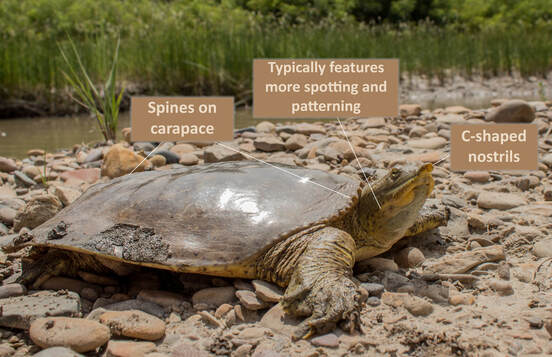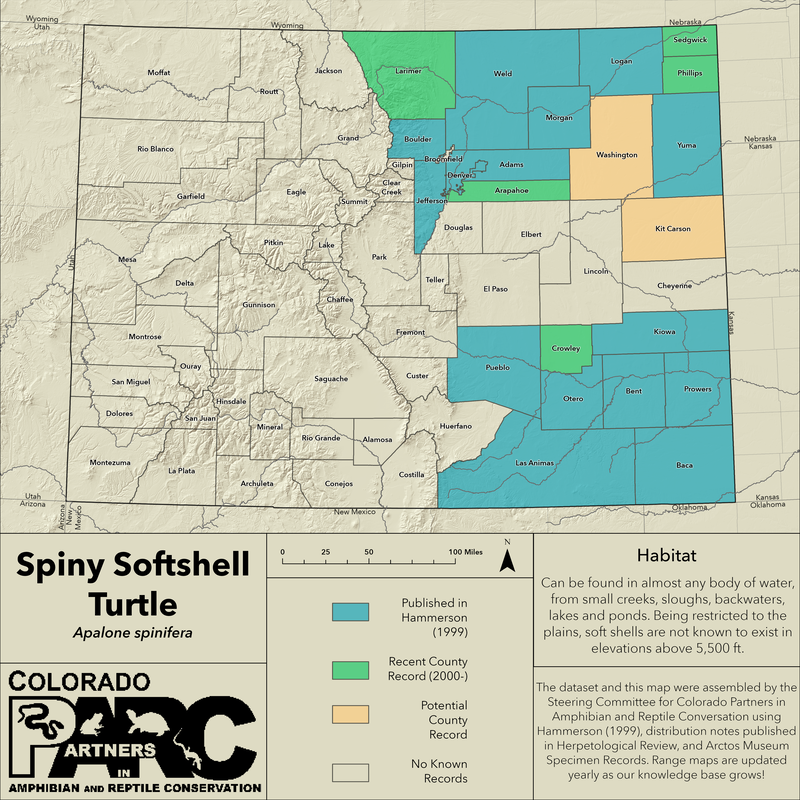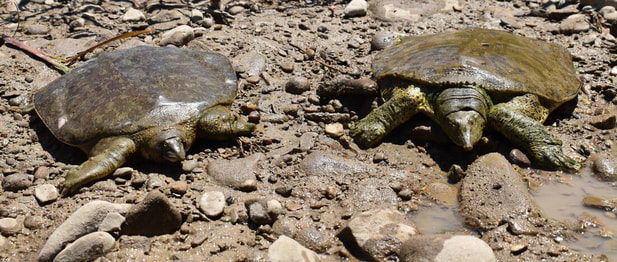Spiny Softshell TurtleApalone spinifera
|
|
Diagnostic Features
Coloration / Markings
Size: It is a sexually dimorphic species with females being the larger gender. Females can reach sizes of up to 20 in in carapace length and males up to 8 in (Colorado Herpetofaunal Atlas).
General Distribution: Apalone spinifera has an extensive range. It can be found as far north as Canada in the southeastern part of Ontario, and as far south as northeastern Mexico the states of Chihuahua, Coahulia, Tamaulipas and Nuevo Leon, and from the east coast in South Carolina and Georgia as far west as California in the southern part of its range and Montana in its northern limits (Ernst & Lovich 2009). Populations in the southwest U.S. and Montana may be disjunct.
Colorado Distribution: Restricted to the Eastern and Central parts of the state, at elevations lower than 6,000 ft. It is dispersed around three main river drainages: the South Platte, Arkansas, and Republican Rivers. It extends as far west as Pueblo and the eastern limits of Denver County (Hammerson 1999).
Habitat: While mostly associated with rivers, Spiny Softshells can be found in almost any body of water, from small creeks, sloughs, backwaters, lakes and ponds (Moll & Moll 2004). Being restricted to the plains, soft shells are not known to exist in elevations above 5,500 ft (Hammerson 1999).
Reproduction: Mating takes place in the spring (Ernst & Lovich 2009). Eggs are then buried in sandbars along the river, but high enough to avoid flooding (Hammerson 1999). The hatchlings emerge in August or September (Hammerson 1999).
|
Activity: Yearly activity in Colorado may begin in early March and can extend to early October if the weather stays warm enough (Hammerson 1999). During this time they start become active early in the morning around (8 a.m.) and remain active until about 7 p.m. at the latest (Ernst & Lovich 2009). Softshells like the weather hot and are usually the only turtle active on days with temperatures in the upper 90’s or low 100’s (Max Maloney, personal observation).On days of activity Softshells can regularly be seen basking on sandbars for much of the morning and afternoon, with periods of foraging in the water (Max Maloney, personal observation). During the colder months, Spiny Softshells, like all turtles in Colorado, hibernate at the bottom of whatever body of water they are in by burying themselves in the substrate (Hammerson 1999).
Feeding & Diet: Softshells are opportunistic feeders, both actively hunting or ambushing live prey, or scavenging on dead animals. They are very good swimmers and can actively hunt down and search for prey. They are also capable ambush predators by burying themselves in the substrate and waiting for prey items to come to them (Ernst & Lovich 2009). They are primarily carnivorous, eating fish, crayfish, insects, or anything that they can capture (Williams & Christiansen 1981).
Defenses from Predation: Softshells, especially adults, are very fast in the water and can easily avoid most predators in the water. They also are well known for burying themselves quickly in the sand when disturbed (Graham & Graham, 1991). Predators of Softshell eggs and nests include raccoons (Procyon lotor), skunks (Mephitis mephitis, Spilogale sp.), opossums (Didelphis virginiana) and foxes (Vulpes sp.) (Hammerson 1999). Young turtles can be taken by large predatory fish, other turtles (Apalone sp., Chelydra serpentina), and water snakes (Nerodia sp.)(Ernst & Lovich 2009). Adult turtles do not have many predators, expect for humans, and Alligators in parts of their range where they are sympatric (Ersnt & Lovich 2009).
|
Cited & Additional Resources
- Ernst, C. H. and J. E. Lovich. 2009. Turtles of the United States and Canada. John Hopkins University Press. Baltimore.
- Graham, T. E. and A. A. Graham. 1991. Trionyx spiniferus spiniferus (Eastern Spiny Softshell): Burying Behavior. Herpetological Review 22: 56-57
- Hammerson G. A. 1999. Amphibians and Reptiles in Colorado. University Press Colorado, Boulder.
- Moll, D., and E. O. Moll. 2004. The ecology, exploitation, and conservation of river turtles. Oxford University Press. New York, N.Y.
- Plummer, M. V. and J. C. Burnley. 1997. Behavior, hibernacula, and thermal relations of softshell turtles (Trionyx spiniferus) overwintering in a small stream. Chelonian Conservation and Biology 2:489–493.
- Plummer, M. V., N. E. Mills, and S. L. Allen. 1997. Activity, habitat, and movement patterns of softshell turtles (Trionyx spiniferus) in a small stream. Chelonian Conservation and Biology 2:514–520.
- Williams, T. A. and J. L. Christiansen. 1981. The niches of two sympatric softshell turtles, Trionyx muticus and Trionyx spiniferus, in Iowa. Journal of Herpetology 15:303–308.
- Graham, T. E. and A. A. Graham. 1991. Trionyx spiniferus spiniferus (Eastern Spiny Softshell): Burying Behavior. Herpetological Review 22: 56-57
- Hammerson G. A. 1999. Amphibians and Reptiles in Colorado. University Press Colorado, Boulder.
- Moll, D., and E. O. Moll. 2004. The ecology, exploitation, and conservation of river turtles. Oxford University Press. New York, N.Y.
- Plummer, M. V. and J. C. Burnley. 1997. Behavior, hibernacula, and thermal relations of softshell turtles (Trionyx spiniferus) overwintering in a small stream. Chelonian Conservation and Biology 2:489–493.
- Plummer, M. V., N. E. Mills, and S. L. Allen. 1997. Activity, habitat, and movement patterns of softshell turtles (Trionyx spiniferus) in a small stream. Chelonian Conservation and Biology 2:514–520.
- Williams, T. A. and J. L. Christiansen. 1981. The niches of two sympatric softshell turtles, Trionyx muticus and Trionyx spiniferus, in Iowa. Journal of Herpetology 15:303–308.
Suggested Citation
Colorado Partners in Amphibian and Reptile Conservation. 2015. Species account for Spiny Softshell (Apalone spinifera). Compiled by Max Maloney. http://www.coparc.org/spiny-softshell.html [accessed date here]. Editor: Danny Martin.
Colorado Partners in Amphibian and Reptile Conservation. 2015. Species account for Spiny Softshell (Apalone spinifera). Compiled by Max Maloney. http://www.coparc.org/spiny-softshell.html [accessed date here]. Editor: Danny Martin.




